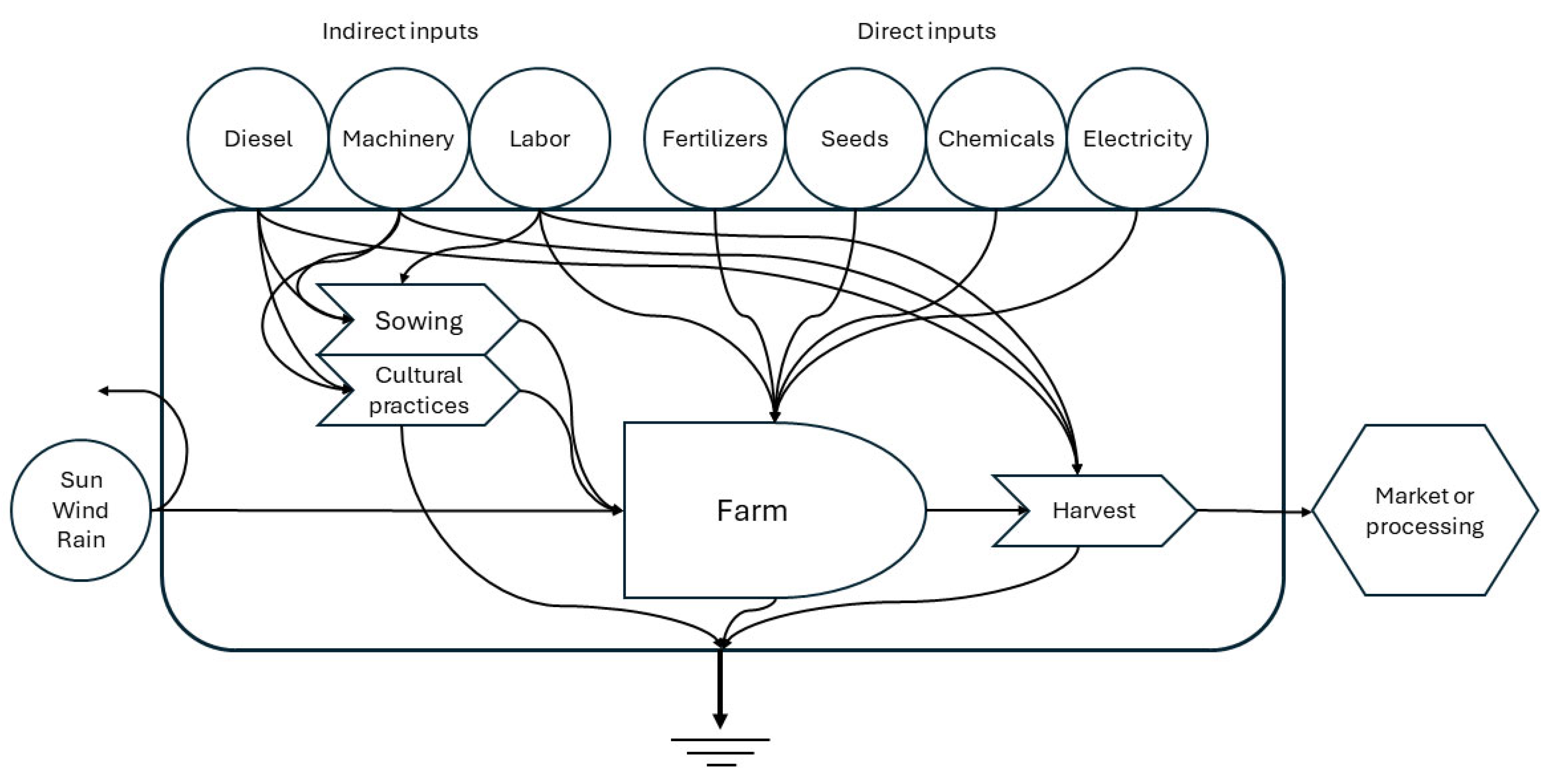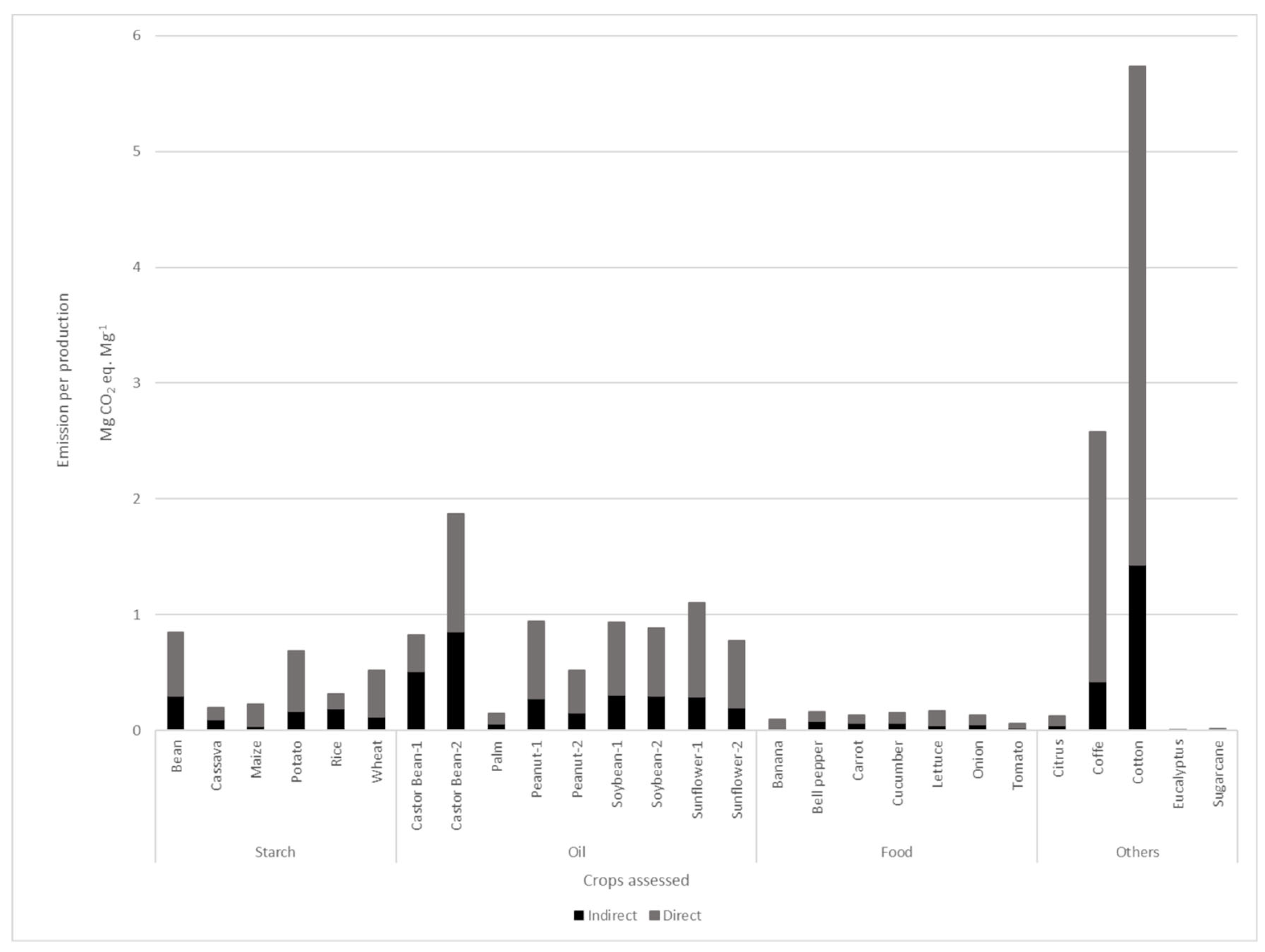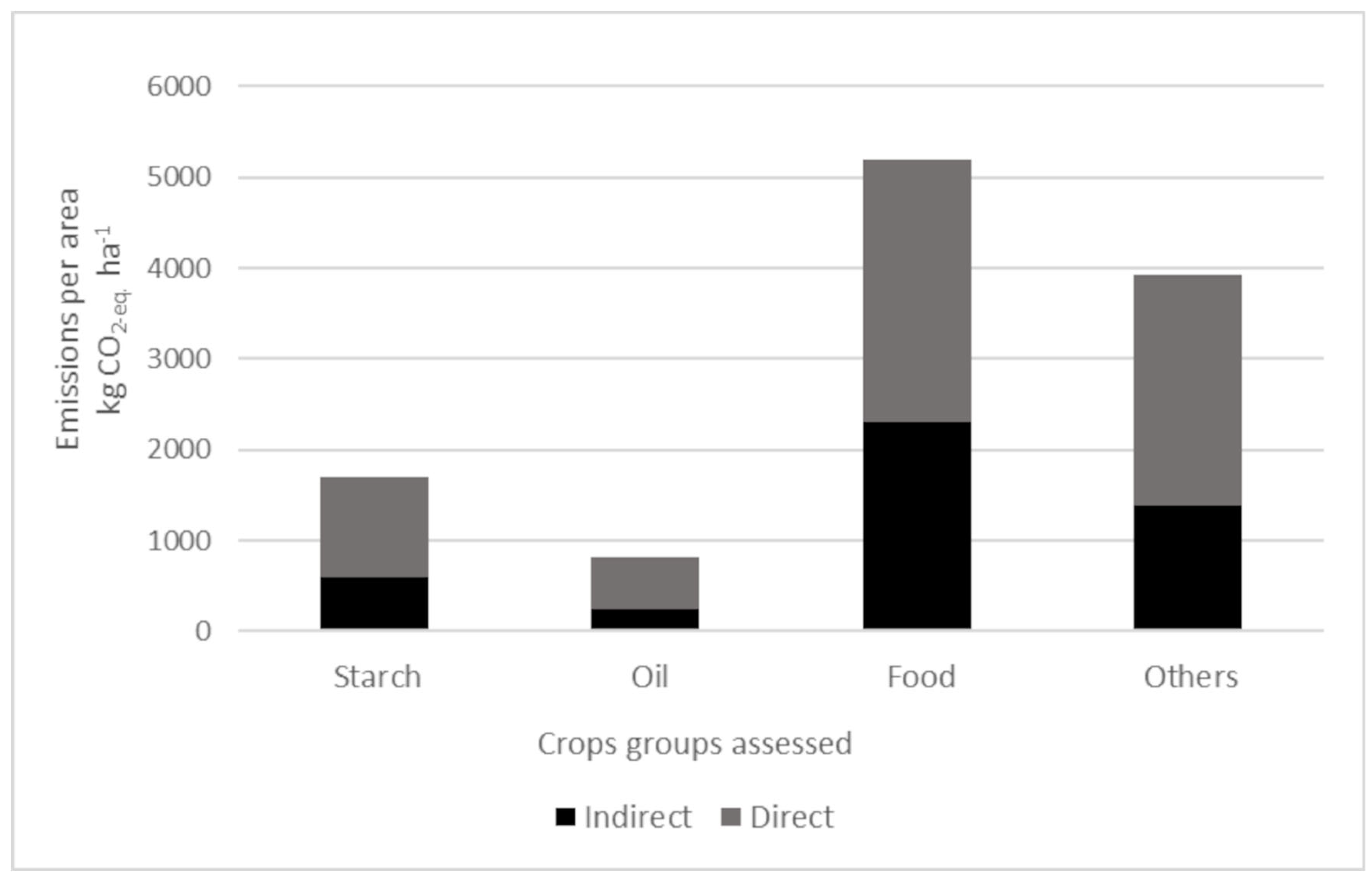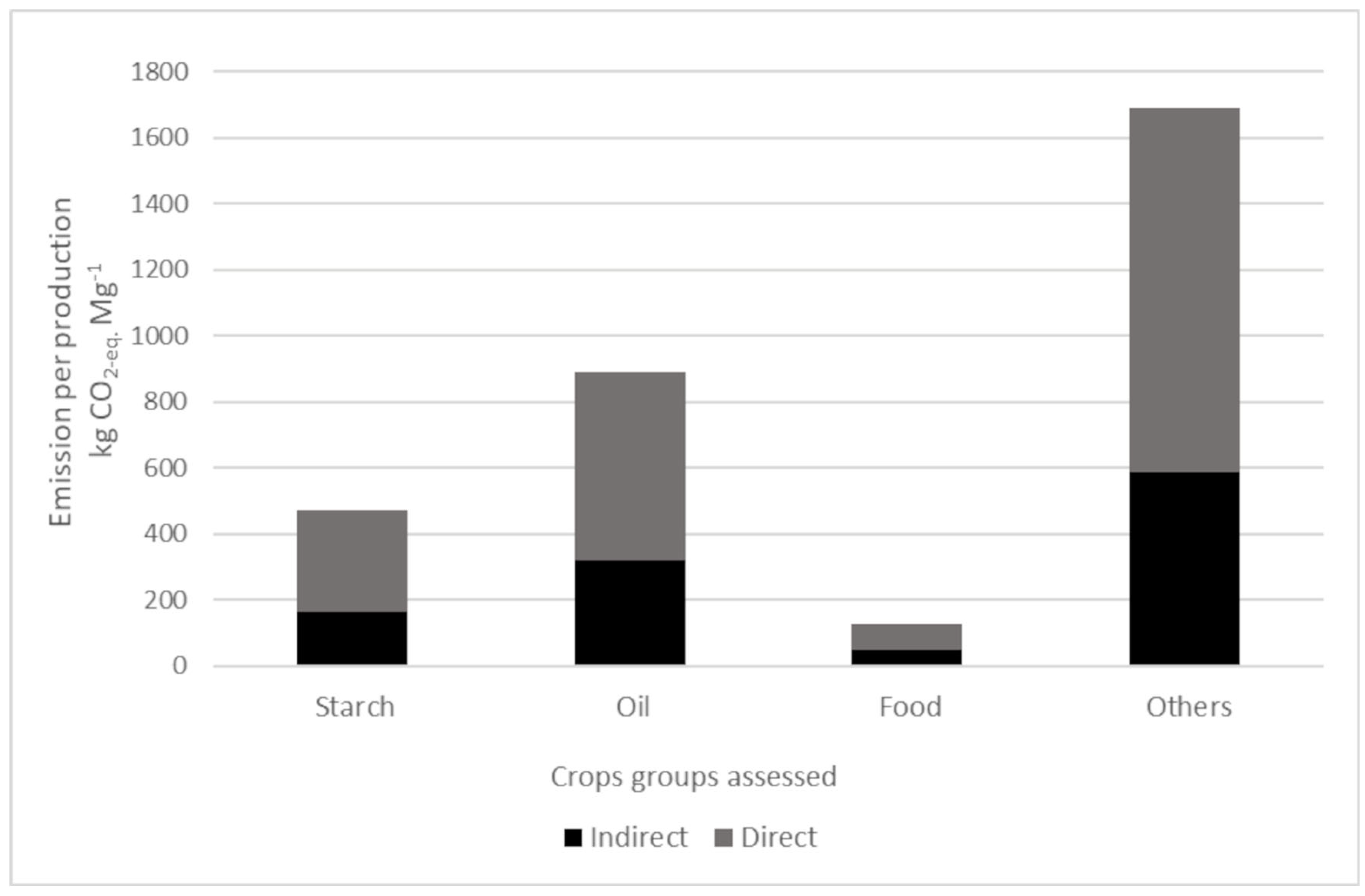Carbon Footprint of Brazilian Agriculture Based on Field Operations
Abstract
1. Introduction
2. Materials and Methods
Emission Factor
3. Results
Direct and Indirect Emissions
4. Discussion
4.1. Assessment by Area
4.2. Assessment by Production
4.3. Assessment by Crop Groups
4.4. Comparison between Crops with Different Systems of Production
4.5. Comparative Evaluation
5. Conclusions
Author Contributions
Funding
Data Availability Statement
Conflicts of Interest
References
- IEA. Key World Energy Statistics 2020; IEA: Paris, France, 2020. [Google Scholar]
- Lamb, W.F.; Wiedmann, T.; Pongratz, J.; Andrew, R.; Crippa, M.; Olivier, J.G.J.; Wiedenhofer, D.; Mattioli, G.; Khourdajie, A.A.; House, J.; et al. A Review of Trends and Drivers of Greenhouse Gas Emissions by Sector from 1990 to 2018. Environ. Res. Lett. 2021, 16, 073005. [Google Scholar] [CrossRef]
- USEPA. Technical Documentation: Atmospheric Concentrations of Greenhouse Gases; United States Environmental Protection Agency: Washington, DC, USA, 2022.
- Lan, X.; Keeling, R. Trends in Atmospheric Carbon Dioxide in Mauna Loa, Hawaii; NOAA: Washington, DC, USA, 2024.
- IEA. IEA—International Energy Agency—IEA. Available online: https://www.iea.org/data-and-statistics/data-sets (accessed on 22 May 2023).
- Pörtner, H.-O.; Roberts, D.C.; Tignor, M.; Poloczanska, E.S.; Mintenbeck, K.; Alegría, A.; Craig, M.; Langsdorf, S.; Löschke, S.; Möller, V.; et al. Climate Change 2022: Impacts, Adaptation and Vulnerability. Contribution of Working Group II to the Sixth Assessment Report of the Intergovernmental Panel on Climate Change; IPCC: Cambridge, UK, 2022; p. 3056. [Google Scholar]
- Denny, D.M.T.; Cerri, C.E.P.; Cherubin, M.R.; Burnquist, H.L. Carbon Farming: Nature-Based Solutions in Brazil. GLCE 2023, 1, 130–137. [Google Scholar] [CrossRef]
- Cerri, C.C.; Maia, S.M.F.; Galdos, M.V.; Cerri, C.E.P.; Feigl, B.J.; Bernoux, M. Brazilian Greenhouse Gas Emissions: The Importance of Agriculture and Livestock. Sci. Agric. Piracicaba Braz. 2009, 66, 831–843. [Google Scholar] [CrossRef]
- IPCC. Climate Change 2022—Mitigation of Climate Change: Working Group III Contribution to the Sixth Assessment Report of the Intergovernmental Panel on Climate Change, 1st ed.; IPCC, Ed.; Cambridge University Press: Cambridge, UK, 2023; ISBN 978-1-00-915792-6. [Google Scholar]
- FAO. Faostat 2023; FAO: Rome, Italy, 2023. [Google Scholar]
- EPE. Balanço Energético Nacional 2022; EPE: Brasilia, Brazil, 2022. [Google Scholar]
- SEEG Sistema de Estimativas de Emissões e Remoções de Gases de Efeito Estufa 2023. Available online: https://plataforma.seeg.eco.br/ (accessed on 22 May 2023).
- Intergovernmental Panel on Climate Change. Climate Change 2014: Mitigation of Climate Change: Working Group III Contribution to the Fifth Assessment Report of the Intergovernmental Panel on Climate Change; Edenhofer, O., Ed.; Cambridge University Press: New York, NY, USA, 2014; ISBN 978-1-107-05821-7. [Google Scholar]
- Veiga, J.P.S.; Romanelli, T.L.; Gimenez, L.M.; Busato, P.; Milan, M. Energy Embodiment in Brazilian Agriculture: An Overview of 23 Crops. Sci. Agric. Piracicaba Braz. 2015, 72, 471–477. [Google Scholar] [CrossRef]
- IBGE SIDRA. Available online: https://sidra.ibge.gov.br/home/pimpfrg/nordeste (accessed on 22 May 2023).
- Novas Pimentas e Pimentões Para a Agricultura Brasileira—Portal Embrapa. Available online: https://www.embrapa.br/busca-de-projetos/-/projeto/204034/novas-pimentas-e-pimentoes-para-a-agricultura-brasileira (accessed on 27 May 2024).
- Roberts, J.; Myrrha, N. SEBRAE: Serviço Brasileiro de Apoio às Micro e Pequenas Empresas. In Institutional Case Studies on Necessity Entrepreneurship; Brewer, J., Gibson, S.W., Eds.; Edward Elgar Publishing: Cheltenham, UK, 2016; ISBN 978-1-78347-233-8. [Google Scholar]
- Eucalipto—Portal Embrapa. Available online: https://www.embrapa.br/florestas/transferencia-de-tecnologia/eucalipto (accessed on 27 May 2024).
- Brazil Diário Oficial da União. Diário Oficial da União; União Federal: Brasília, Brazil, 2021; Section 1; p. 2. (In Portuguese)
- ANP Gasolina. Resolução ANP no 807/2020. Agência Nacional de Petróleo, Gás Natural e Biocombustíveis; Ministério de Minas e Energia: Brasilia, Brazil, 2020. (In Portuguese)
- Cerri, C.E.P.; You, X.; Cherubin, M.R.; Moreira, C.S.; Raucci, G.S.; Almeida Castigioni, B.; Alves, P.A.; Cerri, D.G.P.; Castro Mello, F.F.; Cerri, C.C. Assessing the Greenhouse Gas Emissions of Brazilian Soybean Biodiesel Production. PLoS ONE 2017, 12, e0176948. [Google Scholar] [CrossRef] [PubMed]
- Pereira, L.G.; Cavalett, O.; Bonomi, A.; Zhang, Y.; Warner, E.; Chum, H.L. Comparison of Biofuel Life-Cycle GHG Emissions Assessment Tools: The Case Studies of Ethanol Produced from Sugarcane, Corn, and Wheat. Renew. Sustain. Energy Rev. 2019, 110, 1–12. [Google Scholar] [CrossRef]
- European Commission. Joint Research Centre. JEC Well-to-Tank Report V5: JEC Well to Wheels Analysis: Well to Wheels Analysis of Future Automotive Fuels and Powertrains in the European Context.; Publications Office: Luxembourg, 2020. [Google Scholar]
- FGV-EAESP. Programa Brasileiro GHG Protocol 2023; FGV-EAESP: São Paulo, Brazil, 2023. [Google Scholar]
- IPCC. Synthesis Report of the IPCC Sixth Assessment Report AR6; Dadi, D.K., Zhai, P., Eds.; IPCC: Geneva, Switzerland, 2023. [Google Scholar]
- IPCC. Chapter 2: Mineral Industry Emission. In IPCC Guidelines for National Greenhouse Gas Inventories; Eggelston, S., Buendia, L., Miwa, K., Ngara, T., Tanabe, K., Eds.; IGES: Hayama, Japan, 2006; Volume 3, pp. 1–40. [Google Scholar]
- Kool, A.; Marinussen, M.; Blonk, H. LCI Data for the Calculation Tool Feedprint for Greenhouse Gas Emissions of Feed Production and Utilization GHG; Bio-Ethanol Industry: São José dos Campos, Brazil, 2012. [Google Scholar]
- IPCC. Chapter 11: N2O Emissions from Managed Soils, and CO2 Emissions from Lime and Urea Application. In 2006 IPCC Guidelines for National Greenhouse Gas Inventories; Eggelston, S., Buendia, L., Miwa, K., Ngara, T., Tanabe, K., Eds.; Institute for Global Environmental Strategies: Hayama, Japan, 2006; Volume 4, pp. 1–54. [Google Scholar]
- IPCC. Chapter 11: N2O Emissions from Managed Soils, and CO2 Emissions from Lime and Urea Application. In 2019 Refinement to the 2006 IPCC Guidelines for National Greenhouse Gas Inventories; Buendia, E.C., Tanabe, K., Kranjc, A., Baasansuren, J., Fukuda, M., Ngarize, S., Osako, A., Pyrozhenko, Y., Shermanau, P.F.S., Eds.; IPCC: Geneva, Switzerland, 2019; Volume 4, pp. 1–48. [Google Scholar]
- Brazil Gov. Anexo I Especificações dos Fertilizantes Minerais Simples; Ministério da Agricultura e Pecuária: Brasília, Brazil, 2020.
- Smith, K.A.; Brewer, A.J.; Crabb, J.; Dauven, A. A Survey of the Production and Use of Animal Manures in England and Wales. Soil Use Manag. 2006, 17, 48–56. [Google Scholar] [CrossRef]
- Audsley, E.; Stacey, K.; Parsons, D.J.; Williams, A.G. Estimation of the Greenhouse Gas Emissions from Agricultural Pesticide Manufacture and Use. Cranfield University: Bedford, UK, 2009. [Google Scholar]
- FAO. Global Database of GHG Emissions Related to Feed Crops: Methodology. Version 1. Livestock Environmental Assessment and Performance Partnership; FAO: Rome, Italy, 2017. [Google Scholar]
- Mantoam, E.J.; Angnes, G.; Mekonnen, M.M.; Romanelli, T.L. Energy, Carbon and Water Footprints on Agricultural Machinery. Biosyst. Eng. 2020, 198, 304–322. [Google Scholar] [CrossRef]
- Haverkort, A.J.; Hillier, J.G. Cool Farm Tool—Potato: Model Description and Performance of Four Production Systems. Potato Res. 2011, 54, 355–369. [Google Scholar] [CrossRef]
- Numjuncharoen, T.; Papong, S.; Malakul, P.; Mungcharoen, T. Life-Cycle GHG Emissions of Cassava-Based Bioethanol Production. Energy Procedia 2015, 79, 265–271. [Google Scholar] [CrossRef][Green Version]
- Ishmael, N.A.; Emmanuel, Y.H.B. Evaluation of a Motorized Cassava Peeler with Four Lining Materials. Afr. J. Agric. Res. 2020, 16, 1342–1354. [Google Scholar] [CrossRef]
- BioGrace. Harmonised Calculations of Biofuel Greenhouse Gas Emissions in Europe; BioGrace: Takoma Park, MD, USA, 2015. [Google Scholar]
- Ecoinvent. Ecoinvent, Version 3.7; Ecoinvent: Zürich, Switzerland, 2020.
- West, T.O.; Marland, G. A Synthesis of Carbon Sequestration, Carbon Emissions, and Net Carbon Flux in Agriculture: Comparing Tillage Practices in the United States. Ecosyst. Environ. 2002, 91, 217–232. [Google Scholar] [CrossRef]
- Woods, J.; Brown, G.; Estrin, A. Bioethanol Greenhouse Gas Calculator—Users’ Guide; HGCA, Biomass Energy Group—Centre for Environmental Policy; Imperial College London: London, UK, 2005. [Google Scholar]
- FAO. The Role of Wood Energy in Africa—Appendix 6.1.1. In Forestry Department—Food and Agriculture Organization of the United Nations; Rivero, S., Flood, R., Eds.; FAO: Rome, Italy, 1999. [Google Scholar]
- Rugani, B.; Panasiuk, D.; Benetto, E. An Input–Output Based Framework to Evaluate Human Labour in Life Cycle Assessment. Int. J. Life Cycle Assess. 2012, 17, 795–812. [Google Scholar] [CrossRef]
- Pimentel, D. Handbook of Energy Utilization in Agriculture, 1st ed.; CRC Press: Boca Raton, FL, USA, 1980. [Google Scholar]
- Poore, J.; Nemecek, T. Reducing Food’s Environmental Impacts through Producers and Consumers. Science 2018, 360, 987–992. [Google Scholar] [CrossRef]
- Pari, L.; Alexopoulou, E.; Stefanoni, W.; Latterini, F.; Cavalaris, C.; Palmieri, N. The Eco-Efficiency of Castor Supply Chain: A Greek Case Study. Agriculture 2022, 12, 206. [Google Scholar] [CrossRef]
- Huang, W.; Wu, F.; Han, W.; Li, Q.; Han, Y.; Wang, G.; Feng, L.; Li, X.; Yang, B.; Lei, Y.; et al. Carbon Footprint of Cotton Production in China: Composition, Spatiotemporal Changes and Driving Factors. Sci. Total Environ. 2022, 821, 153407. [Google Scholar] [CrossRef] [PubMed]
- Da Silva Lopes, J.; Kiperstok, A.; De Figueirêdo, M.C.B.; De Almeida Neto, J.A.; Rodrigues, L.B. Assessing the Economic and Environmental Performance of Cleaner Production Practices in Eucalyptus Planted Forests Using Life Cycle Assessment. J. Clean. Prod. 2022, 380, 134757. [Google Scholar] [CrossRef]
- Basso, B.; Antle, J. Digital Agriculture to Design Sustainable Agricultural Systems. Nat. Sustain. 2020, 3, 254–256. [Google Scholar] [CrossRef]
- Lajoie-O’Malley, A.; Bronson, K.; Van Der Burg, S.; Klerkx, L. The Future(s) of Digital Agriculture and Sustainable Food Systems: An Analysis of High-Level Policy Documents. Ecosyst. Serv. 2020, 45, 101183. [Google Scholar] [CrossRef]
- MAPA. Pecuária e Abastecimento. In Plano Setorial Para Adaptação à Mudança do Clima e Baixa Emissão de Carbono na Agropecuária com Vistas ao Desenvolvimento Sustentável (2020–2030): Visão Estratégica Para um novo Ciclo; Ministério da Agricultura, Pecuária e Abastecimento: Brasília, Brazil, 2021; ISBN 9786586803419. [Google Scholar]
- Wolfert, S.; Ge, L.; Verdouw, C.; Bogaardt, M.-J. Big Data in Smart Farming—A Review. Agric. Syst. 2017, 153, 69–80. [Google Scholar] [CrossRef]





| Group | Crop | Yield (Mg ha−1) [14] | Area (103 ha) | Source |
|---|---|---|---|---|
| Starch | Bean | 3.0 | 2715 | [15] |
| Starch | Cassava | 22.0 | 1197 | [15] |
| Starch | Maize | 8.8 | 21,284 | [15] |
| Starch | Potato | 30.0 | 118 | [15] |
| Starch | Rice | 2.7 | 1657 | [15] |
| Starch | Wheat | 2.7 | 3167 | [15] |
| Oil | Castor bean | 0.8–1.5 | 46 | [15] |
| Oil | Palm | 2.2 | 201 | [15] |
| Oil | Peanut | 3.1–4.2 | 221 | [15] |
| Oil | Soybean | 3.2–3.1 | 41,142 | [15] |
| Oil | Sunflower | 4.2 | 38 | [15] |
| Food | Banana | 40.0 | 460 | [15] |
| Food | Bell Pepper | 35.0 | 13 | [16] |
| Food | Carrot | 42.2 | 30 | [17] |
| Food | Cucumber | 44.0 | 5 | Calculated |
| Food | Lettuce | 22.4 | 30 | Calculated |
| Food | Onion | 44.0 | 49 | [15] |
| Food | Tomato | 85.0 | 55 | [15] |
| Others | Cotton | 4.0 | 1649 | [15] |
| Others | Coffee | 2.1 | 1875 | [15] |
| Others | Sugarcane | 78.0 | 9890 | [15] |
| Others | Citrus | 34.0 | 571 | [15] |
| Yield (m3 ha−1) | ||||
| Others | Eucalyptus | 290.5 | 5500 | [18] |
| Input | Unit | kg CO2-eq 1 | ||
|---|---|---|---|---|
| Production 4 | Direct 5 | Total | ||
| Diesel 2 | Liter | 0.66 | 2.65 | 3.30 |
| Gasoline 3 | Liter | 0.50 | 2.13 | 2.63 |
| Input | Unit | Production 3 | Direct 4 | Indirect 5 | Total |
|---|---|---|---|---|---|
| -----------------------------kg CO2-eq 1----------------------------- | |||||
| Nitrogen | kg | 3.53 | 1.35 | 0.54 | 5.42 |
| P2O5 | kg | 0.54 | - | - | 0.54 |
| K2O | kg | 0.61 | - | - | 0.61 |
| Lime | kg | 0.07 | 0.46 | - | 0.53 |
| Poultry manure | kg | 0.12 | 0.02 | 0.14 | |
| Fungicide | kg a.i. 2 | 29.10 | - | - | 29.10 |
| Herbicide | kg a.i. | 26.60 | - | - | 26.60 |
| Insecticide | kg a.i. | 18.90 | - | - | 18.90 |
| Other chemicals | kg a.i. | 25.50 | - | - | 25.50 |
| Seeds | kg | 0.87 | |||
| Seedlings | kg | ||||
| Machinery | kg | 3.90 | - | - | 3.90 |
| Sugarcane harvester | kg | 9.53 | - | - | 9.53 |
| Coffee harvester | kg | 4.89 | - | - | 4.89 |
| Group | Crop | Emissions (kg CO2-eq Mg−1) | Observation | |
|---|---|---|---|---|
| Present Study | Literature | |||
| Food | Banana | 95.23 | 266.00 1 | Yield considered is almost half of the average Brazilian yield |
| Food | Bell pepper | 160.04 | NF | |
| Food | Carrot | 132.52 | 154.00 1 | |
| Food | Cucumber | 155.14 | NF | |
| Food | Lettuce | 165.85 | NF | |
| Food | Onion | 136.09 | 211.00 1 | |
| Food | Tomato | 56.52 | 704.00 1 | Literature consulted considered tomatoes produced in greenhouses with temperature control |
| Oil | Castor Bean-1 | 823.72 | 815.00 2 | |
| Oil | Castor Bean-2 | 1873.11 | 1667.50 | |
| Oil | Palm | 148.59 | 2172.16 1 | This study considered a very low mechanized system comparing with other production systems |
| Oil | Peanut-1 | 945.38 | 548.08 1 | |
| Oil | Peanut-2 | 516.65 | 548.08 1 | |
| Oil | Soybean-1 | 938.22 | 1633.33 1 | |
| Oil | Soybean-2 | 888.30 | 1633.33 1 | |
| Oil | Sunflower-1 | 1105.29 | 558.48 1 | |
| Oil | Sunflower-2 | 775.69 | 558.48 1 | |
| Others | Citrus | 128.38 | 307.00 1 | |
| Others | Coffee | 2583.02 | 10,386.00 1 | Literature considered as a farm process depulping and roasting, not considered in this study |
| Others | Cotton | 5734.67 | 3270.00 3 | |
| Others | Eucalyptus | 2.42 | 2.07 4 | Average on literature results |
| Others | Sugarcane | 11.46 | 72.75 1 | Literature considered the burning of residues |
| Starch | Bean | 849.35 | 811.48 1 | Average pulses considered by literature and not only Phaseolus vulgaris like this work |
| Starch | Cassava | 195.51 | 663.65 1 | Literature considered cassava yield half of what was considered at this study |
| Starch | Maize | 230.42 | 183.94 1 | |
| Starch | Potato | 746.45 | 1652.40 1 | |
| Starch | Rice | 318.55 | 964.18 1 | Literature counting methane emissions from flooding system |
| Starch | Wheat | 520.69 | 491.07 1 | |
Disclaimer/Publisher’s Note: The statements, opinions and data contained in all publications are solely those of the individual author(s) and contributor(s) and not of MDPI and/or the editor(s). MDPI and/or the editor(s) disclaim responsibility for any injury to people or property resulting from any ideas, methods, instructions or products referred to in the content. |
© 2024 by the authors. Licensee MDPI, Basel, Switzerland. This article is an open access article distributed under the terms and conditions of the Creative Commons Attribution (CC BY) license (https://creativecommons.org/licenses/by/4.0/).
Share and Cite
Veiga, J.P.S.; Popin, G.V.; Cerri, C.E.P.; Romanelli, T.L. Carbon Footprint of Brazilian Agriculture Based on Field Operations. Agronomy 2024, 14, 1343. https://doi.org/10.3390/agronomy14071343
Veiga JPS, Popin GV, Cerri CEP, Romanelli TL. Carbon Footprint of Brazilian Agriculture Based on Field Operations. Agronomy. 2024; 14(7):1343. https://doi.org/10.3390/agronomy14071343
Chicago/Turabian StyleVeiga, João P. S., Gustavo V. Popin, Carlos E. P. Cerri, and Thiago L. Romanelli. 2024. "Carbon Footprint of Brazilian Agriculture Based on Field Operations" Agronomy 14, no. 7: 1343. https://doi.org/10.3390/agronomy14071343
APA StyleVeiga, J. P. S., Popin, G. V., Cerri, C. E. P., & Romanelli, T. L. (2024). Carbon Footprint of Brazilian Agriculture Based on Field Operations. Agronomy, 14(7), 1343. https://doi.org/10.3390/agronomy14071343







